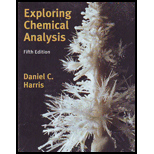
(a)
Interpretation:
Difference between electric charge,
Concept Introduction:
Oxidation process represents loss of electrons while reduction process represents gain of electrons. Oxidation numbers are the part of system that is formed to track electrons in reaction.
(a)
Explanation of Solution
Electric charge is defined as physical property of matter due to that it experiences a force when placed in electric field and it is denoted by
Electric potential is used to measure the ability of voltaic cell to produce electric current and measured in volts
(b)
Interpretation:
Number of electrons in one coulomb has to be determined.
Concept Introduction:
Electric charge is defined as physical property of matter due to that it experiences a force when placed in electric field and it is denoted by
(b)
Explanation of Solution
Unit of electric charge is coulombs. Magnitude of charge of 1 proton is
(c)
Interpretation:
Number of coulomb in
Concept Introduction:
Refer to part (b).
(c)
Explanation of Solution
Unit of electric charge is coulombs. Magnitude of charge of 1 proton is
Want to see more full solutions like this?
Chapter 14 Solutions
Exploring Chemical Analysis
 ChemistryChemistryISBN:9781305957404Author:Steven S. Zumdahl, Susan A. Zumdahl, Donald J. DeCostePublisher:Cengage Learning
ChemistryChemistryISBN:9781305957404Author:Steven S. Zumdahl, Susan A. Zumdahl, Donald J. DeCostePublisher:Cengage Learning ChemistryChemistryISBN:9781259911156Author:Raymond Chang Dr., Jason Overby ProfessorPublisher:McGraw-Hill Education
ChemistryChemistryISBN:9781259911156Author:Raymond Chang Dr., Jason Overby ProfessorPublisher:McGraw-Hill Education Principles of Instrumental AnalysisChemistryISBN:9781305577213Author:Douglas A. Skoog, F. James Holler, Stanley R. CrouchPublisher:Cengage Learning
Principles of Instrumental AnalysisChemistryISBN:9781305577213Author:Douglas A. Skoog, F. James Holler, Stanley R. CrouchPublisher:Cengage Learning Organic ChemistryChemistryISBN:9780078021558Author:Janice Gorzynski Smith Dr.Publisher:McGraw-Hill Education
Organic ChemistryChemistryISBN:9780078021558Author:Janice Gorzynski Smith Dr.Publisher:McGraw-Hill Education Chemistry: Principles and ReactionsChemistryISBN:9781305079373Author:William L. Masterton, Cecile N. HurleyPublisher:Cengage Learning
Chemistry: Principles and ReactionsChemistryISBN:9781305079373Author:William L. Masterton, Cecile N. HurleyPublisher:Cengage Learning Elementary Principles of Chemical Processes, Bind...ChemistryISBN:9781118431221Author:Richard M. Felder, Ronald W. Rousseau, Lisa G. BullardPublisher:WILEY
Elementary Principles of Chemical Processes, Bind...ChemistryISBN:9781118431221Author:Richard M. Felder, Ronald W. Rousseau, Lisa G. BullardPublisher:WILEY





